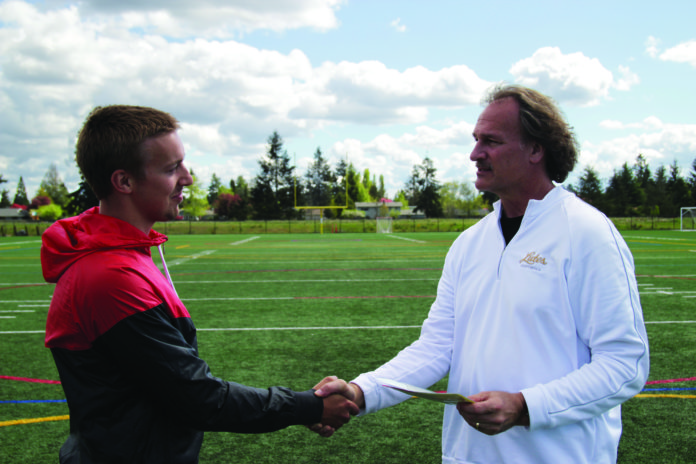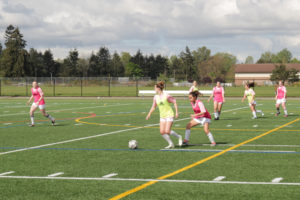
DYLAN FOREMAN; Sports Editor; foremadf@plu.edu
When current head coach of the women’s soccer program Seth Spidahl was an assistant for the University of Washington men’s program in the early 2000’s, he was told that “recruiting is the lifeblood of any program.” The statement holds true not only for women’s soccer but for every aspect of any athletic department. However, at a small Division III liberal arts institution like Pacific Lutheran University, recruiting is not an exact science, but rather a time-consuming ordeal that requires a concerted effort on the part of the athletic department and the coaches within it to help produce academic and talented student-athletes to make PLU a competitive athletic institution.
At PLU, the women’s soccer team and the football team produce the highest volume of recruits every year. For soccer, Spidahl’s rule is to recruit two players for every one player that transfers or graduates. For example, this year he’s losing six seniors, which means he has recruited 12 to help replace the holes in the roster. For football, assistant coach Jud Keim will recruit around 40 players to help fill the depth chart for offense, defense, special teams and scout players.
However, with the inability to offer scholarships, commitments from prospective students range from sparse to too many due to the wide recruiting nets cast by coaches. Because of this, coaches will target their focus on highly academic and highly skilled student-athletes who want an enjoyable, small school experience.

“The selling points are the opportunities this whole campus, and all the departments, and all the resources, and the heart for others that this place offers,” Keim said. “My favorite recruiting line is ‘buildings and bricks don’t talk to you, it’s the human resource here that really makes a difference.’”
For what PLU lacks in state-of-art facilities and equipment, it makes up for with excellent academic standing and the promise of a holistic experience at the school for incoming student-athletes. Compared to other schools at higher levels with more money like Division I, II or even the National Association of Intercollegiate Athletics (NAIA), PLU and other Division III schools don’t stack up because of they can’t give out scholarships and the amenities aren’t as nice. However, Athletic Director Laurie Turner says that PLU offers something special that other schools can’t.
“At Division I, it’s year round, they own you, and for some that’s perfect,” Turner explained. “But for others, they have other interests, they want to be able to do things that a small liberal arts institution allows you to do.”
However, it can be hard to convince incoming student-athletes of the Division III experience, as opposed to the glamorous bigger school experience. One thing that many high school students think is that because it is a smaller school, it must not be competitive, and therefore must not be a true collegiate athletic experience. Keim is quick to point out the misconception.
“We all think it is this big D-1 thing and it is on ESPN, and kids making commitments… you know Alabama or Florida, that is so the one percent of the one percent, that’s the elite…. we are talking about all the other great players.”
When recruits come and visit with Spidahl, he makes a simple comparison. He takes a recruit going to the University of Southern California and a recruit coming to PLU and looks at the difference in growth. Clearly there are two different skill levels going in, but at PLU this recruit has a chance to grow skill-wise as a player, and grow in their vocation. The recruit at USC might not improve as much as a PLU player over the next four years, and will certainly not be able to experience the different opportunities that a smaller school would have to offer.
“They get caught up on the number after the letter D sometimes [(Division I, II or III)] but if they think about what their actually journey is gonna be once they’re there, that’s important to student-athletes,” Spidahl said.
To find the high school students that are genuinely interested in the program, different coaches will go about it different ways. Many of the coaches, including Spidahl, are part-time coaches who coach outside their collegiate team which allows for them to watch recruits on their own and not on PLU’s dime. Spidahl is highly entrenched in the Northwest club soccer scene and is able to recruit while coaching his club teams at tournaments and elite soccer camps. Also, because of their recent success, winning between 14 and 16 games the last few seasons, he is able to recruit while hardly dipping into the PLU women’s soccer recruiting budget.
Other coaches, like Keim, utilize social media as a drawing point for potential recruits. Also, because of the volume of athletes they are looking in a recruiting class, he is able to utilize admission officers as an extension of the athletic department.
“We rely on admission to help us with recruiting. Our admission people will interact with people that interested in coming to PLU,” Turner said. “Our collaboration has been very strong and very helpful.”
The part of the admission office that plays the most importance in a student-athlete’s decision to come to PLU is the financial aid office. For many students, not just potential student-athletes, the full price of tuition can seem daunting, especially if there aren’t any athletic scholarships available at the Division III level. However, the average financial aid package based on merit and need for the 2015-2016 academic year was roughly $30,000 for PLU. In many cases, the cost of tuition can be less than that of a large state school, which helps lure highly academic student-athletes.
According to Turner, at the end of the day, “it is not just recruiting, it’s recruiting and retaining.”
One of the initiatives the athletic department is working on is being able to have official visits for recruits, which could attract more student-athletes from outside states that aren’t within driving distance of Tacoma. These official visits would be paid for by the athletic department, to add another incentive for student-athletes to come play for PLU.
























